|
Portrait of a giant telescope in Germany
- An elusive 42 inch telescope
- While still mentioning Dan Bakken's 41.2" Hercules as the world's largest portable telescope on the 110 cm telescope page earlier this year,
I had already heard a report of a friend about observing with a meter-class Dobsonian at a German star party some years ago.
I had dispensed this account as probably incorrect because there did not seem to be any information about this telescope on the internet.
Surely one would expect that a telescope of this size should leave some traces...
- But recently I stumbled by chance upon some ITV 2003 images about a very impressive 42 inch Dobsonian.
Thanks to some very helpful German ATM'ers on Astro-Treff I managed to contact Dr. Erhard Hänssgen who built the 42 inch (107 cm)
f/4.5 Dobsonian telescope in 2002.
- This telescope is a very well constructed giant and certainly deserves some exposure on the global amateur telescope making scene!
This is about the ultimate Obsession-like Dobsonian telescope you can make, and it's hard to imagine extending this design beyond this limit.
For example the secondary cage is quite heavy at 30 kg (66 lbs) and a lot of people would probably not be able to mount it on the telescope!
If this scope doesn't make you go WOW, what will?
- Erhard kindly agreed to send me some pictures and technical information, and that's what you find below.
The images have been reduced for faster download, but you can click on any picture to see the original full-scale version.
- A lot more pictures of the telescope's construction are shown on the 42 inch Dobsonian Construction Page.
 - You can also find some more pictures of the 42 inch telescope at the following events:
ITV 2003,
7th HTT and
ATV 2007.
Some exchanges with Dr. Erhard Hänssgen
- Erhard Hänssgen's talks about the construction of his giant telescope
- At the time I just built my telescope so it was optimal for me and I could transport and assemble it alone.
It's important that one constructs the telescope for oneself, and not for anybody else.
You're the one that observes with it and all the other are just guests. It's your telescope!
Of course all visitors are very welcome and should be able to use the scope without too much difficulty.
With my telescope there's no problem whatsoever. Every visitor is always surprised how easily the telescope moves and can be piloted.
- I have worked about 14 months on the telescope and, to be honest, occasionally I was frightened by its sheer size.
The starting point for the 42" scope was my 30" f/5 Dobsonian telescope that I had assembled from an AstroSystems TeleKit about 9 years ago.
I did not have to time to design and try out everything from scratch, and the Telekit enabled me to build a telescope reasonably fast without
having any experience with telescope making.
There were a couple of points I did not like in the TeleKit, but after a few changes it became a very good telescope and I
had my first telescope making experience.
- My 42 inch telescope is the first that I completely designed and constructed myself. I started from my the experience with the 30 inch,
and tried to improve all the things that I was not perfectly happy with.
- I constructed my telescope so that it just fits in my trailer. At right and left sides is about 13 mm free space.
The longest parts could not be longer then 3.15 m (10 ft). I can move the telescope completely alone.
At first light a friend told me that my telescope is the biggest transportable in the world, I could hardly believe it!
- In amateur astronomy everybody helps everybody. I learned the basic knowledge from others therefore I'm glad to pass my experience
to other amateur telescope makers.
-
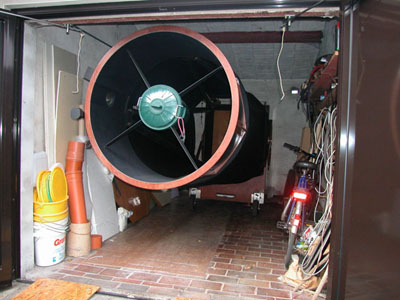

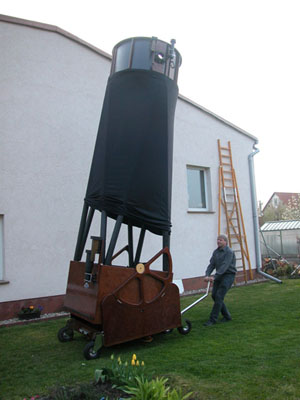
- Question: With the thin 56 mm mirror supported laterally by a side sling, do you not suffer from astigmatism?
- The astigmatism is no major concern. Of course, with such a thin mirror you have to compromise to some extent, but it's not
really a problem. The thin mirror cools down much faster than a thick mirror, which is an advantage when temperature drops in the course of
the night.
- When I use the fans to cool the mirror, I switch them off at least 30 minutes before the observing starts, so that the temperature can
spread more evenly. With the 30 inch this wasn't any problem, but with the 42 inch I can observe the temperature differences in the glass.
- I'm using a 27 point mirror cell because the mirror is so thin. With the 30 inch this was just a minor problem. At a star party I could
not collimate correctly because some of the support points had been squeezed during transport and the mirror was tilted in the telescope; maybe
only half the support points were really used, the other half of the mirror lied on a single point. Even in these conditions some friends
made a star test and were still pretty happy with the quality of the optics. But with the bigger telescope you cannot get away with this!
- Question: How much magnification can you use comfortably? No plans for a motor drive?
- I did not add any motor drive. Even at high magnifications the hand tracking is really no problem. In zenith it's obviously slightly
tougher. To move the scope I've added two handles to the upper cage, because the struts are too widely separated to be used as handles.
- The telescope is usually limited by seeing; with bad seeing one cannot use the higher power. I've already observed planetary nebulae at
1600 power and the hand tracking was really no problem.
- Question: Is this primarily a deep-sky telescope, or do you also have good performance on planets?
- I use the telescope for everything - Sun, Moon, planets, deep-sky. I observe the Sun, Moon and planets mostly with binoviewer, and also
the brighter deep-sky objects. Observing with bino is really gorgeous!
- On the planets the surface brightness usually is too high for comfort, that's why I use an adjustable filter that helps you to reduce the glare and
get the best conditions with optimum surface contrast.
-

Some Technical Data
- General
- The total weight of the telescope is about 350 kg (780 lbs) but it can be moved and set-up by one person.
- Setup time (starting from opening the door of the trailer) by one person is 45 minutes withouth hurrying. The assembly of the telescope
invariably attracts some attention that slows down the process... The first step is obviously putting together the ladder.
- Eyepiece height at zenith is about 4.5 m (15 ft).
- Primary Mirror
- Material: Pyrex
- Supplier: Intermountain Optics (USA)
- Diameter: 42" (1067 mm)
- Focal Length: 4820 mm (190"), f/4.5
- Thickness: 56 mm (2.2") (!!)
- Weight: 97 kg (214 lbs)
- Accuracy: lambda/4
- Mirror cell: 27-point with side-sling (safety belt from car)
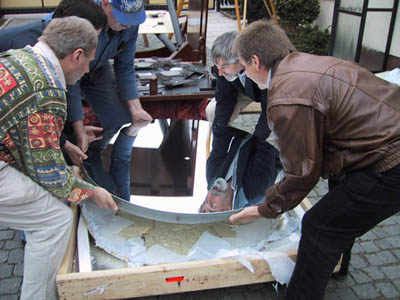 - Secondary mirror
- 8" minor axis secondary with heating (heating only used in extreme humid conditions)
- Adjustments/collimation with 4 bolts
- The secondary mirror is put relatively deep in the secondary cage to reduce dew forming
- Holder: plywood and metal sheet (to attach and adjust)
- At 8" the secondary mirror is quite big, even for this size of scope. In fact the secondary is designed to
use a binoviewer without needing a barlow to reach focus (so the focal point is located at a far greater distance than would normally be required).
 - Secondary Cage
- Total weight: about 30 kg (66 lbs)
- Outer diameter: about 125 cm (49") - the largest size that fits in the trailer
- Height: 60 cm (24")
- Mounted with 8 bolts on the third ring that connects the truss tubes
- Spider: 1 mm stainless steel with 2x1 mm Aluminum glued
- 4" focuser for better rigidity when using the extension tube with 2" connection
(observing with Bino viewer without barlow is important for Sun observation, but this requires the
extension tube for observing without bino with normal eyepiece)
-
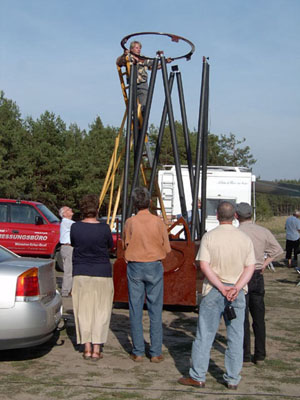
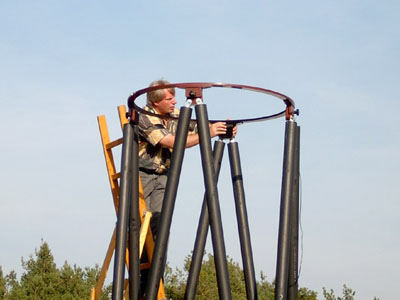
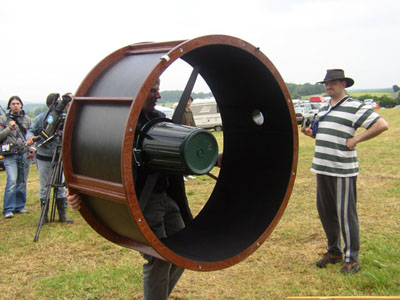
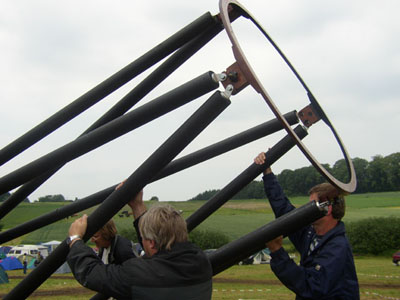
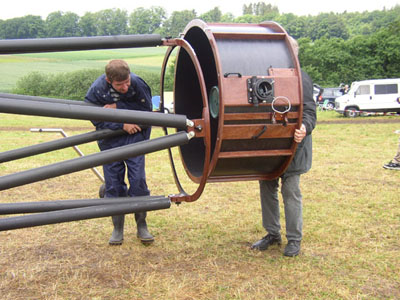

- Trus tubes
- 2" (50 mm) diameter Aluminum tubes, 2 mm (0.078") thickness, about 3 m long
- Thick insulation foam around the tubes (to stretch the light shroud and keep it out of the light path)
- Light shroud: black Jersey silk (thin, elastic and very light material). The shielding is very good - even for observing the Sun.
-
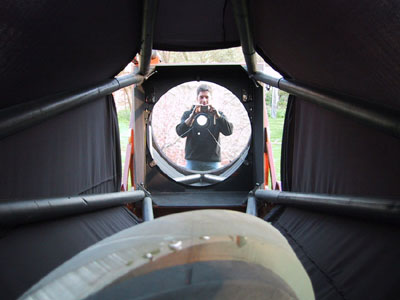
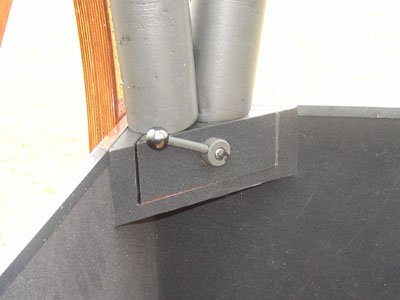
- Mirror box
- Sides 18 mm plywood, bottom 36 mm plywood for the mirror cell
- There are holes in the bottom for better cooling and to look through when collimating. The holes can be covered to keep out dust.
- The bottom has 4 fans and the 3 collimation bolts. Erhard preferred a closed mirror cell design to reduce dust on the mirror
- The altitude trunions have been cut from the upper cage rings topped with Ebonystar.
- Lateral guidance of the mirror box in the rocker box with 2 x 9 bearings (no ball bearings required)
-
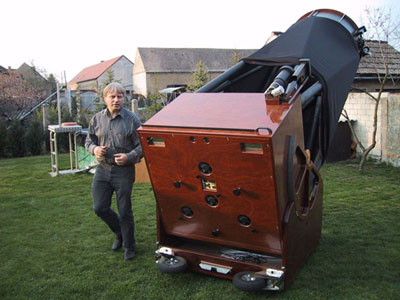
- Rocker box
- 36 mm plywood with cut-outs to reduce the weight
- Metal ring on the bottom as rolling surface for the ball bearings on the ground board
- The ground board has 3 x 9 narrow ball bearings with a breaking system on which the rocker rides
-
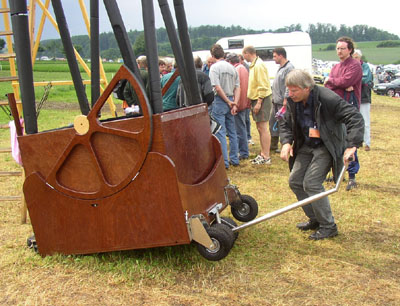
- Wheels
- Four castors with pneumatic tiers that can be rotated and secured with a safety pin through a spring-loaded bolt.
There are four additional safety screws for transport in trailer.
- You need to use the wheel barrow and lift the telescope to turn it
-
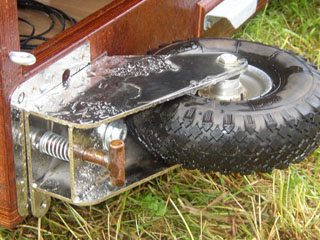
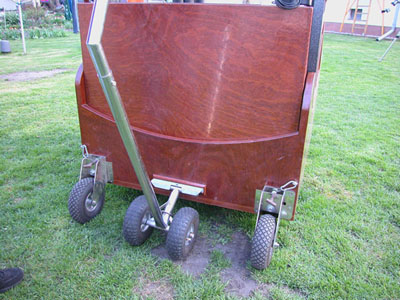
- Observing Ladder
- Home made from wood, height about 5 m (16 ft), width about 50 cm (20")
- Split after about 3 m, connection over a metal join and 2 bolts
- Can be taken apart for transport in parts not longer than 201 cm (door height)
-
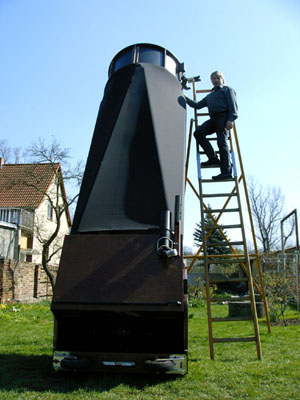
- Trailer
- The telescope just fits in the trailer with only 13 mm to spare on the sides.
The longest parts could not be longer then 3,15 m (10 ft).
- The rocker box/mirror box weighing 300 kg (660 lbs) is put in the trailer with a cable winch.
-
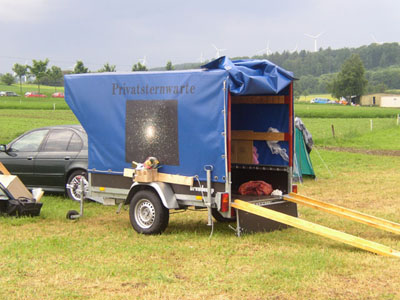
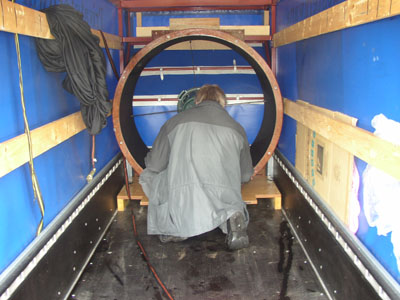
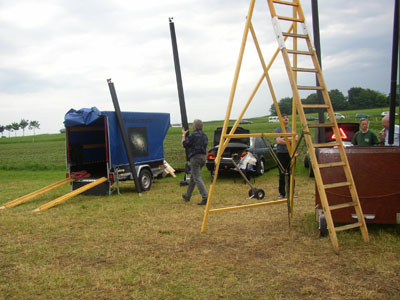



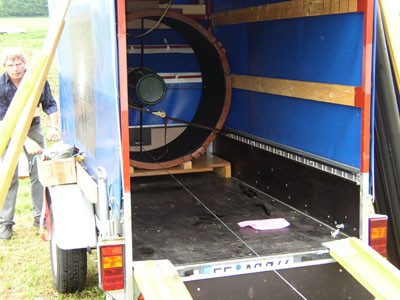

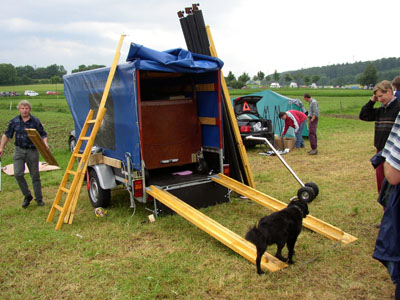
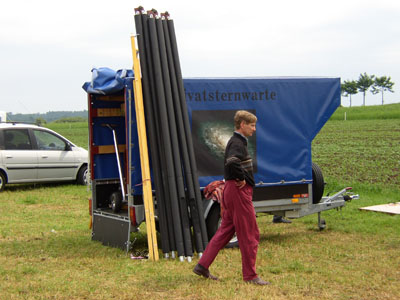
A final thought
- If everything goes well with both the 110 cm Cruxis telescope and Hughes Laroche's project for a 113 cm (currently in the mirror grinding stage),
in a couple of years some of the world's largest portable amateur telescopes will be found in Western Europe in the 800 km long strip
Brussels-Luxembourg-Dresden around 50 degrees latitude.
Curiously, also Danny Cardoen, the precursor who constructed around 1985 the 106 cm telescope at Puimichel in the French Provence, originates from about 100 km west of Brussels.
Must be the cloudy weather in Western Europe that gives amateur astronomers plenty of time to dream away...

July 2007, Robert Houdart
| |